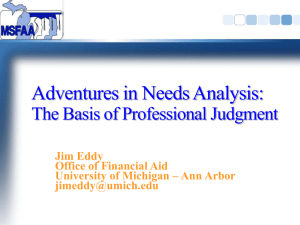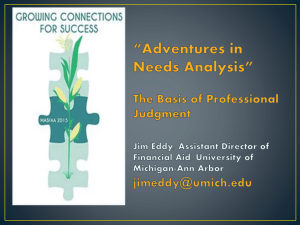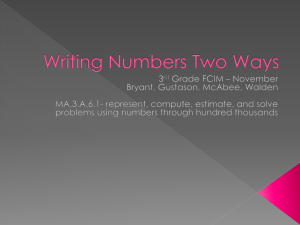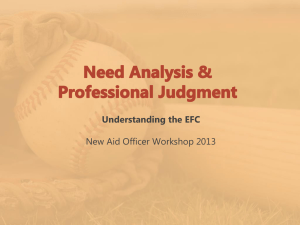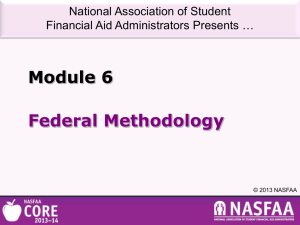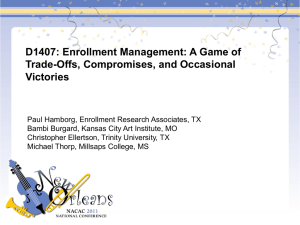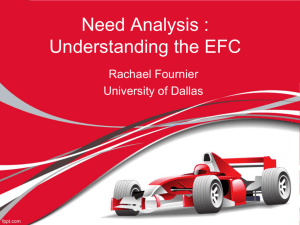ccraa - msfaa
advertisement
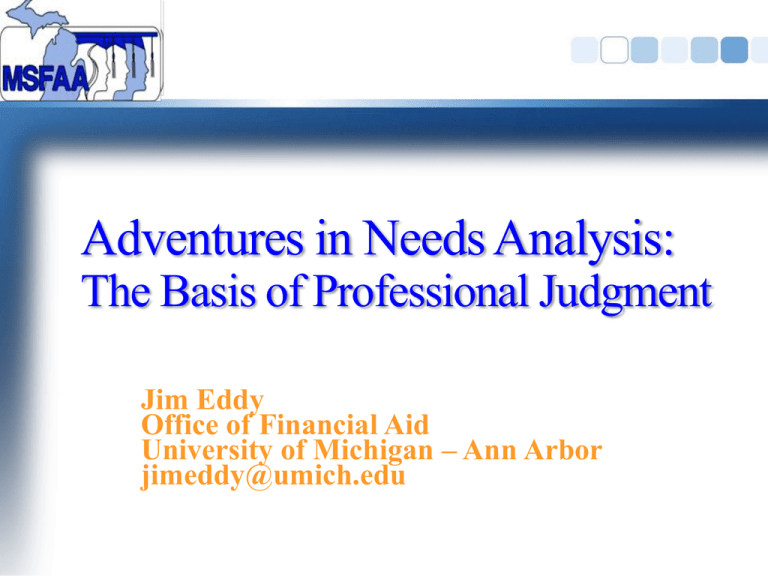
Adventures in Needs Analysis: The Basis of Professional Judgment Jim Eddy Office of Financial Aid University of Michigan – Ann Arbor jimeddy@umich.edu In this session we will: • Do FM needs analysis together, then talk about it • Review/revisit the EFC Formula Guide • Discuss PJ in the context of knowing the calculation • If we have time: Look at regulatory changes to FM EFC data elements over time, & discuss IM (Institutional Methodology) Dependent Student Case Study: Let’s dive in! The Case: Narrative Scarlett White is a cheerleader enrolled as a senior at Huron High School in Ann Arbor. Her brother Jesse will be a college Junior at Wayne State University, where he studies chemistry. Brother Alphonso is entering 7th grade, and sister Holly will again be in elementary school. Scarlett is the aid applicant for this case study. The Case: Narrative, con’t. The parental AGI for 2014 was $83,821. Dad (Walter White, pharmaceutical executive and former high school chemistry teacher), age 52, earned $199,214 in wage income, and mom (Skyler, age 46, financial executive and car wash owner) earned $163,277. A massive net loss from Line 17 of their Form 1040 (Vamonos Pest LLC; Los Pollos Hermanos Partners; A1A Car Wash S-Corp) largely accounts for their reduced AGI. They filed a Form 1040 and itemized their deductions, with a federal tax paid of $6,021. Walt and Skyler claimed all 4 children as 2014 tax exemptions. They are careful money managers despite their IRS paper losses, and have budgeted exactly $2015 for Scarlett’s 2015-2016 educational expenses. The Case: Narrative, con’t. Walt and Skyler claimed a 2014 IRA deduction in the amount of $2000. They also claimed a Hope Educational credit for Arthur in the amount of $1500. Due to an earlier divorce agreement, Walt paid out $6000 in 2014 child support to one of his ex-wives. As parents they have $1,941 in savings, $78,257 in combined 529 savings plans for all 4 kids, and $10,885 in a money market fund. Scarlett did not file a 2014 tax return, and listed earned wage income of $1821. She had $5 in her savings account on the day she filed her FAFSA. Arriving at Total Parent Income 1. 2.a. 2.b. 3. 4. 5. 6. 7. Parent’s 2014 AGI: Father’s work income Plus Mother’s work income Equals total Parent work inc. Parent’s taxable income Untaxed income: Taxable and Untaxed Less offsets to income Equals Total Parent Income 83821 199214 163277 362491 83821 2000 85821 <7500> 78321 Getting Parent Available Income (AI) 8. 2013 U.S. tax paid 9. State/other tax (TableA1) 10. Father’s FICA (Table A2) 11. Mother’s FICA (Table A2) 12. Income Protection Allow (T. A3) 13. Employment Expense Allowance 6021 3133 10143 9622 34310 4000 14. Total Allowances: 67229 Total Income (from line 7) Minus Total Allowances 15. Equals Available Income (AI) 78321 <67229> 11092 Parent Asset Contribution (exploding the mythology) 16. 17. 18. 19. 20. 21. 22. 23. 24. Cash & Savings Net Worth of Investments Net Worth Business/Inv. Farm Adjust. Net. W. Business/Farm (A4) Net Worth (sum 16, 17, 19) Edu. Savings/asset protect. (A5) Discretionary Net Worth (20-21) Asset Conversion rate (multiply by .12) Contribution from assets 1941 89142 0 0 91083 33500 57583 6910 Finally…Parent Contribution Parent’s Available Income (line 15) Plus Asset Contribution (line 24) 11092 6910 25. Equals Adjusted Available Income 18002 26. Total contrib. from AAI (Table A6) 4030 27. # in college (exclude parents) 28. Equals Parent Contribution 2 2015 Student Contribution: Total income 29. 30. 31. 32. 33. 34. Student AGI Student’s work income Taxable income Untaxed income: Total, taxed/untaxed Less offsets to income 0 1821 1821 0 1821 0 35. Equals Total Income 1821 Student Contribution: Allowances 36. 37. 38. 39. 40. 41. Student tax paid State/other tax (Table A7) Student FICA (Table A2) Income Protection Allow. Allow. for Parent Neg. AAI Total allowances 0 55 139 6310 0 6504 42. 43. Total Income (line 35) Less Total Allow. (line 41) Equals Available Inc. (AI) Assessed at .50 1821 6504 <4683> 0 44. Equals Student Cont. from AI 0 Student Contribution: Assets and Overall EFC 45. 46. 47. 48. 49. 50. Student cash, etc. Student investments Student bus./farm New Worth (sum 45-47) Assessed at 20 percent Contribution from assets: 5 0 0 5 1 1 Parent Contribution (line 28) Plus Student AI Contrib. (line 44) Plus Student Cont. from assets 2015 0 1 51. 2016 Equals Overall EFC How many different EFC formulas/worksheets are there, anyway? Seven 1. Dependent Student, Regular 2. Dependent Student, Simplified 3. Independent, without Dependents other than a Spouse, Regular 4. Independent, without Dependents other than a Spouse, Simplified 5. Independent, with Dependents other than a Spouse, Regular 6. Independent, with Dependents other than a Spouse, Simplified 7. Auto Zero Professional Judgment (PJ): Dealing with the “What If’s” If you know how the FM EFC formula works, you can efficiently respond to “what if” questions and utilize appropriate Professional Judgment Some PJ Examples • • • • Medical/Dental costs: 11% is already in the IPA “I saved a lot, so I won’t get financial aid” “I lost my job, so I will get more aid…right?” “We now have 2 in college, so our aid will double, right?” • “We took money out of our IRA…please help us, this is not our real income from work!” • “We are saving for our grandchild…should we put the money into an UGMA?” • My parent just died…will I get more aid?” Regulatory changes to FM EFC College Cost “HERA” Reduction and Access Act of 2007: Higher Education “CCRAA” Reconciliation Act of 2005 Protecting Student Income HERA increased the CCRAA increased this income protection further: allowance for dependent AY2009-2010 - $3,750 students from $2,200 to AY2010-2011 - $4,500 $3,000 AY2011-2012 - $5,250 AY2012-2013 - $6,000 AY2013-2014 - $6,260 Now: $6310 Change in definition of “Total Income” Effective July 1, 2009, CCRAA changed the definition of “total income” by excluding: • • • • • • Welfare benefits Earned Income Credit Special fuels credit Excluded foreign income Untaxed Social Security benefits Additional Child Tax credit “Independent Student” Definition Former language: “…an orphan or ward of the court or was a ward of the court until the individual reached the age of 18…” Current language: “…is an orphan, in foster care, or a ward of the court, at any time when the individual is 13 years of age or older…” “Independent Student” con’t. CCRAA added additional categories: “…is an emancipated minor or is in legal guardianship as determined by a court of competent jurisdiction…” “…has been verified during the school year in which the application is submitted as either an unaccompanied youth who is a homeless child…or as unaccompanied, at risk of homelessness, and self-supporting… Asset Definition HERA added “qualified education benefit” to the definition of assets. CCRAA addressed the ownership of these accounts: • • Student asset if an Independent student If a dependent student, the asset is considered the parent’s whether the owner is the student or parent Simplified Needs Test CCRAA made two changes to the eligibility standards for the simplified needs test. The first change added a new category of eligibility – dislocated workers (& displaced homemakers). The dislocated worker was defined in the Workforce Investment Act of 1998. Sometimes a big impact – assets ignored Auto Zero EFC CCRAA changed the qualifying standard: • Income limit moved from $20,000 to $30,000 • Directed ED to adjust this limit annually based on increases in the CPI • But, this has subsequently been tinkered with, and for 2015-16, the limit is now down to $24,000 Where you can find all the FM info you might ever want http://ifap.ed.gov/efcformulaguide/attachments/090214EFC FormulaGuide1516.pdf • This is annually updated, the worksheets and tables you used today are right out of the guide • Lots of definitions (i.e. Dependency, Simple Needs, Auto Zero, needs-tested benefits) are in there • All the different hand calculation worksheets are there for different FM formulas Institutional Methodology “IM”: Who uses it? • Many privates, some publics, often using the CSS Profile • There is a cost involved for filers, with some waiver exceptions • Non Custodial Parent (NCP) data can also be requested • Home equity is considered; significant number of formulaic differences relative to FM IM: Why use it? • When “compelling budgetary concerns” make overall higher EFC’s desirable • When your institution believes all students are best served by a more realistic assessment of family financial strength • When another filter is helpful to sort out families who by any reasonable definition are likely not grant eligible • As an avenue to simply get Non Custodial Parent (NCP) data • Your answer here: Other “IM” options include • Institutional aid applications (sometimes for both needs analysis and scholarships) • Cherry picking some CSS Profile outputs • Running parallel processing, sing CSS Profile calculation within PC spreadsheet or other software • Calculating need for international students • Other? Q&A GO FORTH AND PROSPER!
